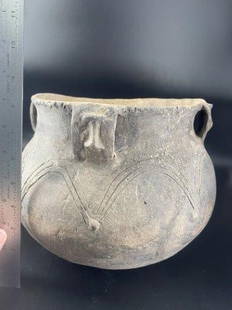
TAPA CLOTH, PAPUA NEW GUINEA (ORO PROVINCE,
Similar Sale History
View More Items in Tribal & Native American ArtifactsRelated Tribal & Native American Artifacts
More Items in Tribal & Native American Artifacts
View MoreRecommended Art
View More


Item Details
Description
COLLINGSWOOD BAY)
Three:
20th c.
Beaten barkcloth
36" x 63", 25" x 61", 42" x 49"
Provenance
Collection of Adam Vai Delaney, Papua New Guinea
Allan Stone Collection, New York (acquired from the above in 1997)
Tapa is generally the more popularly understood term for “beaten barkcloth” from the paper mulberry or breadfruit tree. For hundreds of years, tapa-making was one of the most sophisticated plant-fiber technologies in the Pacific Islands. In the eighteenth century and before, tapa served as both daily and ceremonial clothing. It was made into headdresses, turbans, loincloths, sashes, girdles, skirts, and ponchos. The cloth was used for bedcovers, wall dividers, or mosquito curtains as well as for special wrappings of staff gods, for the outer layer of sculptures, for wrapping skulls, and for masks. Individuals were surrounded by tapa at birth, weddings, and death. Special cloths were made for dowries, diplomatic gifts, and treaty agreements. Large-scale accumulation of tapa signified wealth and aided in achieving status. It was also used to pay tribute. Barkcloth material, partially processed or as undecorated sheets, was an important trade item and was exchanged for plaited mats, adzes, whaleteeth, and sandalwood. The preservation of tapa is especially difficult in island climates because of wide fluctuations in temperature, humidity, and light. Eventually, the increased availability of woven cotton cloth made in Asia and Europe led to a significant decline of hand-produced tapa, altered its use, and encouraged further changes in the ways in which tapa was decorated. Tapa is produced today on many islands, including Tonga, Fiji, Samoa, Hawaii, the Cook Islands (Atiu), and Papua New Guinea, and serves local needs as well as the tourist trade. Cloths are still used for ceremonial and special occasions—as masks and clothing for dances and for presentation in marriages and funerals—and as decoration on the walls of public buildings and homes.
References
Wrapped in Tapa: Its Role and Use, Embedded Nature: Tapa Cloths from the Pacific Islands, Online Exhibitions, Peabody Museum of Archaeology and Ethnology https://www.peabody.harvard.edu/node/2271
Three:
20th c.
Beaten barkcloth
36" x 63", 25" x 61", 42" x 49"
Provenance
Collection of Adam Vai Delaney, Papua New Guinea
Allan Stone Collection, New York (acquired from the above in 1997)
Tapa is generally the more popularly understood term for “beaten barkcloth” from the paper mulberry or breadfruit tree. For hundreds of years, tapa-making was one of the most sophisticated plant-fiber technologies in the Pacific Islands. In the eighteenth century and before, tapa served as both daily and ceremonial clothing. It was made into headdresses, turbans, loincloths, sashes, girdles, skirts, and ponchos. The cloth was used for bedcovers, wall dividers, or mosquito curtains as well as for special wrappings of staff gods, for the outer layer of sculptures, for wrapping skulls, and for masks. Individuals were surrounded by tapa at birth, weddings, and death. Special cloths were made for dowries, diplomatic gifts, and treaty agreements. Large-scale accumulation of tapa signified wealth and aided in achieving status. It was also used to pay tribute. Barkcloth material, partially processed or as undecorated sheets, was an important trade item and was exchanged for plaited mats, adzes, whaleteeth, and sandalwood. The preservation of tapa is especially difficult in island climates because of wide fluctuations in temperature, humidity, and light. Eventually, the increased availability of woven cotton cloth made in Asia and Europe led to a significant decline of hand-produced tapa, altered its use, and encouraged further changes in the ways in which tapa was decorated. Tapa is produced today on many islands, including Tonga, Fiji, Samoa, Hawaii, the Cook Islands (Atiu), and Papua New Guinea, and serves local needs as well as the tourist trade. Cloths are still used for ceremonial and special occasions—as masks and clothing for dances and for presentation in marriages and funerals—and as decoration on the walls of public buildings and homes.
References
Wrapped in Tapa: Its Role and Use, Embedded Nature: Tapa Cloths from the Pacific Islands, Online Exhibitions, Peabody Museum of Archaeology and Ethnology https://www.peabody.harvard.edu/node/2271
Condition
Condition reports are rendered as specialist opinion by the staff of the Auction House and/or independent consultants and not as statements of fact. We do not guarantee the content of written or verbal condition reports. The absence of a condition report does not imply that there are no condition issues with the lot. ?? ?Please call us at (609) 397-9374 or e-mail info@ragoarts.com with any questions about this lot at least 24 hours prior to auction.?
Buyer's Premium
- 30%
TAPA CLOTH, PAPUA NEW GUINEA (ORO PROVINCE,
Estimate $300 - $900
6 bidders are watching this item.
Shipping & Pickup Options
Item located in Lambertville, NJ, usSee Policy for Shipping
Payment

Related Searches
TOP










































































![[SEX] LOT OF 9 PHOTOGRAPHS SOLD TOGETHER: [SEX] A lot of 9 photographs sold together. Some postcards. One mounted with plastic corners in archival mat. Prints: 4.5" x 3" - 6" x 4". Generally good condition, various imperfections. *Additional](https://p1.liveauctioneers.com/8124/329546/177689790_1_x.jpg?height=310&quality=70&version=1715469494)





![Emilio Grau-Sala "Sur la Plage" Oil on Canvas: Emilio Grau-Sala (Spanish, 1911-1975), "Sur la Plage" [On The Beach], Oil on Canvas, 1958, signed "Grau Sala" lower right, signed, inscribed "Trouville", dated, and titled to verso. 21.5" H x 25.75" W](https://p1.liveauctioneers.com/5649/328023/176731071_1_x.jpg?height=310&quality=70&version=1714409606)